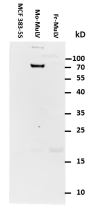Analysis of two monoclonal antibodies reactive with envelope proteins of murine retroviruses: one pan specific antibody and one specific for Moloney leukemia virus
- PMID: 24556162
- PMCID: PMC3983920
- DOI: 10.1016/j.jviromet.2014.02.006
Analysis of two monoclonal antibodies reactive with envelope proteins of murine retroviruses: one pan specific antibody and one specific for Moloney leukemia virus
Abstract
Many monoclonal antibodies (MAbs) reactive with various proteins of murine leukemia viruses (MuLVs) have been developed. In this report two additional MAbs with differing and unusual specificities are described. MAb 573 is reactive with the envelope protein of all MuLVs tested including viruses in the ecotropic, xenotropic, polytropic and amphotropic classes. Notably, MAb 573 is one of only two reported MAbs that react with the envelope protein of amphotropic MuLVs. This MAb appears to recognize a conformational epitope within the envelope protein, as it reacts strongly with live virus and live infected cells, but does not react with formalin-fixed or alcohol-fixed infected cells or denatured viral envelope protein in immunoblots. In contrast, Mab 538 reacts only with an epitope unique to the envelope protein of the Moloney (Mo-) strain of MuLV, a prototypic ecotropic MuLV that is the basis for many retroviral tools used in molecular biology. MAb 538 can react with live cells and viruses, or detergent denatured or fixed envelope protein. The derivation of these antibodies as well as their characterization with regard to their isotype, range of reactivity with different MuLVs and utility in different immunological procedures are described in this study.
Keywords: Amphotropic MuLV; Env protein; Moloney MuLV; Monoclonal antibodies; Retroviruses.
Published by Elsevier B.V.
Figures





Similar articles
-
A neutralizable epitope common to the envelope glycoproteins of ecotropic, polytropic, xenotropic, and amphotropic murine leukemia viruses.J Virol. 1990 Dec;64(12):6176-83. doi: 10.1128/JVI.64.12.6176-6183.1990. J Virol. 1990. PMID: 1700832 Free PMC article.
-
Endogenous retroviral env expression in primary murine leukemias: lack of xenotropic antigens but presence of distinct mink cell focus-forming env subtypes correlating with ecotropic virus inoculated and mouse strain.J Natl Cancer Inst. 1987 Jan;78(1):181-9. doi: 10.1093/jnci/78.1.181. J Natl Cancer Inst. 1987. PMID: 3025502
-
Characterization of monoclonal antibodies reactive with murine leukemia viruses: use in analysis of strains of friend MCF and Friend ecotropic murine leukemia virus.Virology. 1983 May;127(1):134-48. doi: 10.1016/0042-6822(83)90378-1. Virology. 1983. PMID: 6305011
-
Characterization of epitopes defining two major subclasses of polytropic murine leukemia viruses (MuLVs) which are differentially expressed in mice infected with different ecotropic MuLVs.J Virol. 1994 Aug;68(8):5194-203. doi: 10.1128/JVI.68.8.5194-5203.1994. J Virol. 1994. PMID: 7518532 Free PMC article.
-
A small region of the ecotropic murine leukemia virus (MuLV) gag gene profoundly influences the types of polytropic MuLVs generated in mice.J Virol. 1997 Nov;71(11):8923-7. doi: 10.1128/JVI.71.11.8923-8927.1997. J Virol. 1997. PMID: 9343260 Free PMC article.
Cited by
-
SERINC5 Potently Restricts Retrovirus Infection In Vivo.mBio. 2020 Jul 14;11(4):e00588-20. doi: 10.1128/mBio.00588-20. mBio. 2020. PMID: 32665269 Free PMC article.
-
Endogenous Retroviruses Provide Protection Against Vaginal HSV-2 Disease.Front Immunol. 2022 Jan 4;12:758721. doi: 10.3389/fimmu.2021.758721. eCollection 2021. Front Immunol. 2022. PMID: 35058919 Free PMC article.
-
Mouse APOBEC3 expression in NIH 3T3 cells mediates hypermutation of AKV murine leukemia virus.Virology. 2018 May;518:377-384. doi: 10.1016/j.virol.2018.03.014. Epub 2018 Mar 30. Virology. 2018. PMID: 29605684 Free PMC article.
-
A B cell screen against endogenous retroviruses identifies glycan-reactive IgM that recognizes a broad array of enveloped viruses.Sci Immunol. 2024 Nov 8;9(101):eadd6608. doi: 10.1126/sciimmunol.add6608. Epub 2024 Nov 8. Sci Immunol. 2024. PMID: 39514636 Free PMC article.
References
-
- Chattopadhyay SK, Lander MR, Gupta S, Rands E, Lowy DR. Origin of mink cytopathic focus-forming (MCF) viruses:comparison with ecotropic and xenotropic murine leukemia virus genomes. Virology. 1981;113:465–483. - PubMed
-
- Chesebro B, Britt W, Evans L, Wehrly K, Nishio J, Cloyd M. Characterization of monoclonal antibodies reactive with murine leukemia viruses: use in analysis of strains of friend MCF and Friend ecotropic murine leukemia virus. Virology. 1983;127:134–148. - PubMed
Publication types
MeSH terms
Substances
Grants and funding
LinkOut - more resources
Full Text Sources
Other Literature Sources

